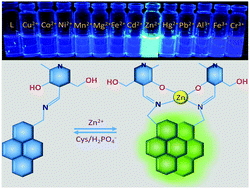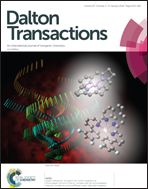Three-in-one type fluorescent sensor based on a pyrene pyridoxal cascade for the selective detection of Zn(ii), hydrogen phosphate and cysteine†
Abstract
A novel fluorescent receptor L was synthesized by Schiff base condensation of 1-pyrenemethylamine with the vitamin B6 cofactor pyridoxal. The receptor L is highly selective and sensitive towards Zn2+ ions among other tested metal ions. Upon interaction with Zn2+, the receptor L showed a distinct fluorescence enhancement at 485 nm due to the excimer formation leading to the fluorescent colour change from blue to bluish-green. Subsequently, when the in situ generated ZnL2 complex interacted with various anions and amino acids, the addition of H2PO4− and cysteine reinstated the fluorescence of the receptor L due to the demetalation of Zn2+ from the ZnL2 complex. Accordingly, the receptor L was developed for the highly selective, specific and sensitive detection of three important bioactive analytes, i.e., Zn2+, H2PO4− and cysteine with a detection limit down to 2.3 × 10−6 M, 2.18 × 10−7 M and 1.59 × 10−7 M, respectively. Additionally, the receptor L was applied to the detection of intracellular Zn2+ ions in live HeLa cells.



 Please wait while we load your content...
Please wait while we load your content...